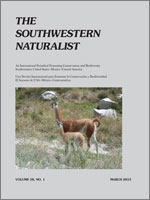During 2009 and 2010, we observed common side-blotched lizards (Uta stansburiana) in two types of vegetation along the Virgin River in Nevada and Arizona: monotypic stands of nonnative saltcedars (Tamarix) and mixed stands of cottonwoods (Populus fremontii), willows (Salix gooddingii), mesquites (Prosopis), and saltcedar trees. Using mark-recapture techniques, parameters were recorded from 233 individual lizards. We detected no significant difference in parameters between monotypic stands of nonnative saltcedars and mixed vegetation. However, lizards selected habitats having a more open vegetative structure and parameters were correlated negatively with canopy cover. Greatest canopy cover occurred in sites having >65% stem counts for saltcedar trees. Our results suggest that common side-blotched lizards use habitats with similar structural characteristics in both mixed and nonnative vegetation, and that they avoid sites with dense canopy cover as in the densest stands of saltcedars.
Durante 2009 y 2010, observamos las lagartijas costado manchado (Uta stansburiana) en dos tipos de vegetación a lo largo del río Virgin en Nevada y Arizona: rodales de cedro salado (Tamarix) no nativo y rodales mixtos de álamo (Populus fremontii), sauce (Salix gooddingii), mezquite (Prosopis), y cedro salado. Utilizando técnicas de marca-recaptura, obtuvimos parámetros poblacionales de 233 individuos. No encontramos ninguna diferencia significativa en los parámetros entre lugares dominados por el cedro salado y lugares con vegetación mixta. Sin embargo, las lagartijas seleccionaron hábitats que tienen una estructura de vegetación más abierta y los parámetros se correlacionaron negativamente con la cobertura del dosel vegetal. El dosel vegetal mayor fue encontrado en sitios donde >65% del conteo de tallos fue de cedro salado. Nuestros resultados sugieren que las lagartijas costado manchado utilizan hábitats con similares características estructurales tanto de vegetación mixta como de vegetación no nativa, y evitan sitios con un dosel vegetal denso, tales como se encuentran en rodales densos únicamente de cedro salado.





